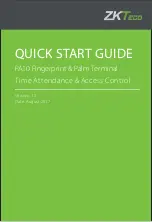
Watlow PM LEGACY™ Limit Controller
•
91
•
Chapter 8 Features
Latching
A latched alarm will remain active after the alarm condition has passed. It can only be deactivated by
the user. An active message, such as an alarm message, will cause the display to toggle between the
normal settings and the active message in the up-
per display and
attn
in the lower display. Push the
Advance Key to display
ignr
in the upper display
and the message source in the lower display. Use
the Up or Down
key
to scroll through pos-
sible responses, such as Clear
CLr
or Silence
SiL
.
Then push the Advance or Reset key to execute
the action.
See the Keys and Displays chapter and the
Home Page chapter for more details. An
alarm that is not latched (self-clearing) will de-
activate automatically when the alarm condition
has passed. Turn latching on or off with Latching
a.La
(Setup Page, Alarm Menu).
Silencing
If silencing is on the operator can disable the alarm output while the controller is in an alarm state.
The process value or temperature has to enter the normal operating range beyond the hysteresis
zone to activate the alarm output function again. An active message, such as an alarm message, will
cause the display to toggle between the normal settings and the active message in the upper display
and
attn
in the lower display.
1. Push the Advance Key to display
ig n r
in the upper display and the message source in the lower
display.
2. Use the Up
or Down
key
to scroll through possible responses, such as Clear
CLr
or Silence
siL
. Then push the Advance or Reset key to execute the action.
See the Keys and Displays chapter and the Home Page chapter for more details. Turn silencing on or
off with Silencing
asi
(Setup Page, Alarm Menu).
Blocking
Blocking allows a system to warm up after it has been started up. With blocking on, an alarm is not
triggered when the process temperature is initially lower than the low set point or higher than the high
set point. The process temperature has to enter the normal operating range beyond the hysteresis
zone to activate the alarm function. Turn blocking on or off with Blocking
a.bL
(Setup Page, Alarm
Menu).
Using Lockout and Password Security
If unintentional changes to parameter settings might raise safety concerns or lead to downtime, you
can use the lockout feature to make them more secure. There are two methods of lockout that can be
deployed, both of which are accessible from the Factory Page.
Method 1- Change the value of the Read Lock
rLoC
(1 to 5) and Set Lock
sLoC
(0 to 5) prompts
where the higher the value or setting for each translates to a higher security clearance
(greater access).
Method 2- Enable Password Security
p a s .E
and then modify the Lock Level
LoC.L
value which rang-
es from 1 to 5. See the section entitled
“Using Lockout Method 2”
for more detail.
Normal Operating Range
High
Set Point
Time
Temperature
Low
Set Point
Alarm Response with Hysteresis
The alarm state continues until the
temperature drops to the Alarm High
Set Point minus the hysteresis. A
latching alarm could be turned off by
the operator at this point. A
non-latching alarm would turn off
automatically.
The alarm state begins when the temperature
reaches the Alarm High Set Point
Process
Temperature
Hysteresis
















































